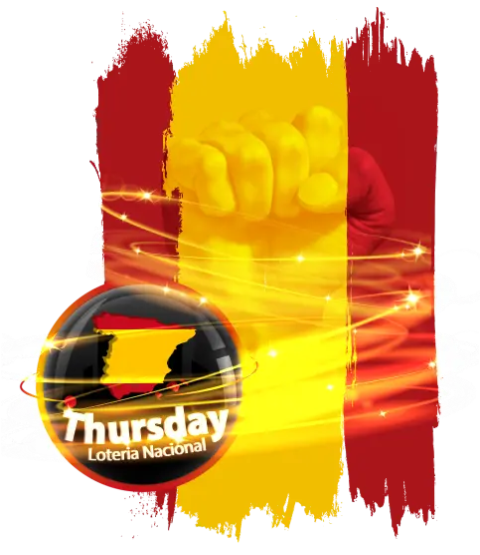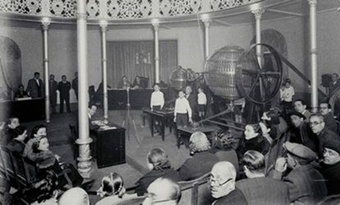Loteria Nacional Thursday: The Spanish Weekly Lotto that Packs a Punch
Every Thursday - Salsa Your Way to 300K!
Play Now

About Loteria Nacional Thursday
The National Lottery of Loterias y Apuestas carries out weekly draws every Thursday, the draw is held at 9:00 p.m. and ticket sales close at 6:00 p.m. To participate, you can choose whether to buy small tickets, known as tenths, or bigger tickets known as series. After this, you must select the 5-digit number with which you want to play. The issue of weekly draws every Thursday consists of 6 series of 100,000 tickets each. The draw every Thursday in the National Lottery distributes 2 million euros through jackpots and other bonuses. The first prize awards 300,000 euros per series, and a second great bonus of 60,000 euros per series. The Thursday draws have the first prize of €30,000 per tenth. According to official data, the odds of winning any prize is 1 in 3.
What time is the Thursday Lottery draw held?
The draw takes place every Thursday are held at 9:00 p.m. The runtime is usually a little shorter than the live drawing on Saturdays, about eighteen minutes, so by 9:20 p.m. the results have been published online.
The Thursday national lottery draw is the only one that is held every Thursday of the year and operates separately from the rest of the draws (Christmas, Child, Specials). This is an alternative to the Saturday lotto, which can be interrupted by the Extraordinary draws around the year.
All Thursday lottery draws are held in the Loterías y Apuestas del Estado (LAE) draw room. Thursday lottery tickets, just like the other National Lottery draws, expire after three months. Spain has one of the longest deadlines in the lottery industry.
Distribution of Prizes in the Thursday Lottery
Number of Awards | Category | Series Award | Tenth Prize |
|---|---|---|---|
1 | First Prize (Five Figure Extraction) | 300.000€ | 30.000€ |
1 | Second Prize (Five Figure Extraction) | 60.000€ | 6.000€ |
40 | 4 four-digit draws | 750€ | 75€ |
700 | 7 three-digit draws | 150€ | 15€ |
9000 | 9 two-digit draws | 60€ | 6€ |
2 | Approximations for the numbers before and after the First Prize | 12.000€ | 1.200€ |
2 | Approximations for the numbers before and after the Second Prize | 7.470€ | 747€ |
99 | Remaining Numbers of First Prize Hundreds | 300€ | 30€ |
99 | Remaining numbers from the hundreds of the Second Prize | 150€ | 15€ |
9 | Last four figures of the First Prize | 750€ | 75€ |
99 | Last three figures of the First Prize | 150€ | 15€ |
999 | Two last figures of the First Prize | 60€ | 6€ |
9999 | Reimbursement with the last figure of the First Prize | 30€ | 3€ |
10000 | Reinstatement (first special extraction) | 30€ | 3€ |
10000 | Reinstatement (second special extraction) | 30€ | 3€ |
History of the National Lottery
In Spain, the birth of the Lottery can be traced back to 1763, during the reign of Carlos III. The then Minister of Finance, the Marquis of Esquilache, established the Primitive Lottery in order to bolster struggling public funding. The Spanish Public Treasury was going through difficult times in which, despite the continuous reforms of the fiscal system, it was not possible to stop the growing public deficit. The lottery emerged disguised under the guise of a game in which everyone could participate and obtain prizes, with the cost of a ticket being so low that you could play for pennies. With Royal Decree on 30th September 1763, the lottery in Spain is established.
Establishing the lottery in Spain
The first draw of this Royal Lottery, known as the "benefit", was held, only for the citizens of Madrid on 10th December. This lottery was considered a failure, with low participation and general distrust of its motivations. In 1767 in order to increase profits, the lottery game was reformed, increasing prize distribution and making it illegal to play any other game of chance, whether foreign or domestic, however, it was only during the reign of Carlos IV, that the draw began to be appreciated, as more people began to play and the public saw an increase in charitable causes. The State donated part of the profits to hospitals, charity centres, the clergy, hospices and pensions for state workers.
The Invasion and The Lottery
In 1769, another lottery was established in Mexico, which consisted of printing each draw in whole, half or quarter tickets, in a similar fashion to the mode currently done with tenths and series. This type of lottery would be the one that almost a century later displaced the original Primitiva lottery when the idea was brought to Spain. On 23rd November 1811, all regions unanimously approved the proposal for this new type of lottery, which was intended to increase the battered coffers of the Treasury due to the bloody conflict being fought against Napoleon in the Peninsular War from 1807 to 1814.
The first draw of what is now known as the National lottery was held on 4th March 1812. The game system was very similar to the one we know today, the bills were printed to distribute between the 250 prizes available.
At first, the celebration of the draws was limited to Cádiz and San Fernando, but later they expanded to Ceuta and later, with the withdrawal of the Napoleonic armies, they spread through Andalusia to the rest of Spain. The last modern lottery draw held in Cadiz took place on 27th January 1814, before the tradition returned to Madrid, holding its first draw on 28th February of that same year.
A Tradition Begins to Cement in History
The public approval created by this lottery among the entire population made the monarch Fernando VII think of introducing “extraordinary” raffles with greater prizes that would appear throughout the year. The Christmas one being the most widely accepted and the one that has remained a tradition since 1892, although this draw did not provide tenths until 1897, making participation difficult amongst the working class and therefore it was more widely celebrated after this date.
Both lotteries, primitive and modern, coexisted for more than half a century, but given the public's preference for the latter, in 1862 the primitive lottery was suppressed by the Government. In 1881, the State intensified the monopoly by legally prohibiting all permanent raffles and private lotteries. In 1904 the prohibition of foreign lotteries was sanctioned and in 1913 all operational charity lottery licences were suspended. With these measures in place, the State achieved absolute power over the lottery industry.
Over the following years, the number of regular and extraordinary draws was increased, but only a small number went on to be played today. The first Red Cross draw was held on 11th October 1924, which still runs to this day, but instead with a switch to Summer to be played in June annually.
The Spanish Civil War & The Lotto Significance
During the outbreak of the Spanish Civil War starting in 1936, three years before World War II, Spain was divided into two territories, both of which held lottery draws. Valencia was initially established as the headquarters of the lottery before being moved to Barcelona. The first lottery held in Barcelona coincided with Christmas and took place on 22nd December 1937 in the Café Lyon Dór.

Other cities also joined in holding extraordinary raffles of a restricted scope in order to raise funds for the benefit of the armies. Zaragoza, Cádiz, Seville, Jerez de la Frontera, Córdoba, Granada, Cáceres, Badajoz, La Coruña, Pontevedra and even the Balearic Islands, issued their corresponding tickets with the denomination of the Patriotic Lottery.
On the other side of the dispute, the "National Zone", established Burgos as the city where the draws were to be held, holding the first of them on 1st April 1938, at the Colegio de Los Hermanos Maristas. This lasted one year before returning to Madrid in July 1939 after the end of the war.
After The War and Modern Cultural Significance
In the coming years, there were changes and variations both in the draw dates, as well as in the prices and number of issues, although no major changes were made, except with the El Niño Lottery, which finally achieved its modern name. In 1958, due to the financial boom experienced by the lottery, Spain attended the second International Congress of State Lotteries. In 1962, an International Lottery Exhibition was held, commemorating the second centenary of the Spanish Lottery. On 4th March 1969, the 5,000th draw was held in Cadiz, marking the original location significance of the Spanish National Lottery.
In the 1970s the National Lottery underwent a computerizing sensation. The government released services and introduced magnetic numbering and new techniques in the ticket distribution process. The number of raffles increased to 50 a year, and in 1979 a Royal Decree sets the expiration date for the collection of prizes at 3 months, lowering the time from 6 months.
The national lottery continued to pay homage to the world of Culture, the Press and the Theater, commemorating the celebration of important international events, such as the World Cup in Spain in 1982 or the Fifth Centenary of the Discovery of America.
The Birth of Thursday Lottery
In the 1990s, the celebration of Extraordinary Raffles continued, with one taking place in Mexico in homage to the original idea taken back in 1769.
In July 1991, the National Lottery introduced a new raffle that would be held fortnightly and came to be known as the "Zodiac Draw", whose name comes from the peculiarity of replacing the traditional 0 to 9 numbers of the series with the twelve zodiacal signs. At first, there were only four fortnightly draws held, but the format was then changed in September 1991 to be held on a weekly basis. In July 1993, this draw changed its prize structure but kept its price and was renamed the "Millionaire Zodiac."
On 3rd February 1994, under slow sales, the Zodiac game is retired, and is replaced with a lottery called the "Thursday Draw"
To conclude, and as we have been able to observe throughout the history of the Spanish National Lottery’s origins and how it came to be to this day. Although all the El Gordo lotteries tend to have their own sort of history, the true origins start way back in the 1700s with King Carlos III and except for small variations over the course of these more than 200 years of life, it can be stated as predicted by Laureano Figuerola, Minister of Hacienda in 1870, the Spanish National Lottery has stood the test of time; with the result of being able to hope, bring generosity, enjoy community and family and be an important source of income for supporting those who need it most. And last but not least, to increase the well-being of those who have had the fortune to be graced with its prizes over the past 200 years.